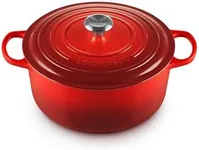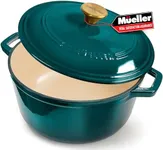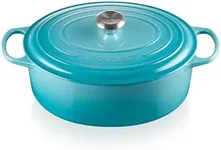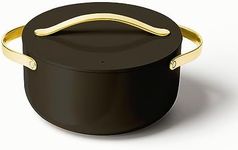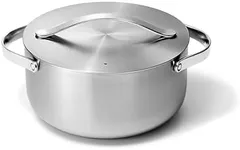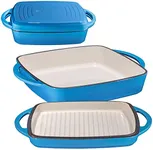Buying Guide for the Best Dutch Oven For Induction Cooktop
Choosing the right Dutch oven for your induction cooktop can significantly enhance your cooking experience. A Dutch oven is a versatile piece of cookware that can be used for a variety of cooking methods, including braising, baking, and simmering. When selecting a Dutch oven for an induction cooktop, there are several key specifications to consider to ensure you get the best fit for your needs. Understanding these specifications will help you make an informed decision and enjoy the full benefits of your Dutch oven.MaterialThe material of the Dutch oven is crucial because it affects heat distribution and compatibility with induction cooktops. Induction cooktops require cookware with a magnetic base, so materials like cast iron and stainless steel are ideal. Cast iron is excellent for even heat distribution and retention, making it perfect for slow-cooking and braising. Stainless steel is also a good option, especially if it has an aluminum or copper core for better heat conduction. Choose cast iron if you prefer slow-cooked meals and durability, or stainless steel if you want a lighter option with good heat conduction.
SizeThe size of the Dutch oven determines how much food you can cook at once. Dutch ovens typically range from 3 to 8 quarts. A 3-4 quart Dutch oven is suitable for small families or individuals, while a 5-6 quart size is ideal for medium-sized families. For larger families or if you often cook for gatherings, a 7-8 quart Dutch oven would be more appropriate. Consider your typical cooking needs and the number of people you usually cook for when choosing the size.
ShapeDutch ovens come in round and oval shapes. The shape can affect how the Dutch oven fits on your induction cooktop and how you use it. Round Dutch ovens are more common and fit well on most cooktops, making them versatile for various cooking tasks. Oval Dutch ovens are better for cooking larger cuts of meat or whole poultry, as they provide more surface area. Choose a round Dutch oven for general use and versatility, or an oval one if you frequently cook large roasts or poultry.
WeightThe weight of the Dutch oven can impact how easy it is to handle, especially when it's full of food. Cast iron Dutch ovens are generally heavier than stainless steel ones. While a heavier Dutch oven can provide better heat retention and even cooking, it may be more challenging to lift and move. If you have difficulty handling heavy cookware, consider a lighter stainless steel option. Otherwise, a heavier cast iron Dutch oven can offer superior cooking performance.
LidThe lid of the Dutch oven plays a significant role in moisture retention and heat distribution. A tight-fitting lid helps to lock in moisture and flavors, which is essential for slow-cooking and braising. Some lids come with self-basting spikes that help to evenly distribute moisture over the food. When choosing a Dutch oven, ensure the lid fits snugly and consider features like self-basting spikes if you want to enhance the cooking process. A good lid will help you achieve better cooking results.
Interior CoatingThe interior coating of the Dutch oven affects its cooking performance and ease of cleaning. Enamel-coated cast iron Dutch ovens are popular because they do not require seasoning and are easier to clean. They also prevent food from reacting with the metal, which can be important for acidic dishes. Bare cast iron requires seasoning but offers a natural non-stick surface over time. Choose enamel-coated for ease of use and maintenance, or bare cast iron if you prefer traditional cookware and don't mind the extra care.


